Book Reviews - Novels
ENT EraDiscoverseTOS and Movie EraTNG EraPost-Nemesis Era
ENT Era
Rise of the Federation: Patterns of Interference
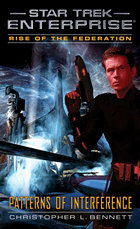 Patterns of Interference is the fifth novel in the Rise of the Federation series, Christopher L. Bennett's sequence of adventures for the characters of Star Trek: Enterprise. The series charts the earliest events of the United Federation of Planets through the 2160s, both following on from threads from episodes of Enterprise and working backwards from various historical bits and pieces mentioned in other series.
Patterns of Interference is the fifth novel in the Rise of the Federation series, Christopher L. Bennett's sequence of adventures for the characters of Star Trek: Enterprise. The series charts the earliest events of the United Federation of Planets through the 2160s, both following on from threads from episodes of Enterprise and working backwards from various historical bits and pieces mentioned in other series.
Previous novels in the series have followed up on the deadly technological threat from "Dead Stop," named by Bennett as the Ware, which has been neutralised with unforeseen consequences for the local galactic neighbourhood. First contact has been made with the planet Sauria but Federation trade with the despotic Maltuvis has led the planet into political chaos. The Rigel system has joined the Federation, but this itself has led to political fallout among such powers as the Orion Syndicate and a breakout movement from the Malurian system. It's fair to say that in a few years the UFP has made a big impact in local space, but frequently with unpredictable consequences.
This lies at the heart of the novel, as Admiral Jonathan Archer campaigns for the creation of a non-interference directive to prevent reckless meddling in the affairs of other peoples. Don't expect to see the founding of the Prime Directive here, though; Bennett understands that policy decisions like this take years to come into effect. Archer has to deal with both logical and impassioned pleas against non-interference, including from his enemy-turned-friend Shran. Meanwhile, other organisations have a vested interest in Starfleet becoming so shamed by its interference that the Federation retreats into isolationism. Multiple factions play against each other, in a plot that increases in complexity as different characters come together at the hotbed that is Sauria.
Bennett's prose is always a pleasure to read. He knows how to spin a good adventure. There's also a good deal of social commentary in his work, and this novel is no exception, as the author uses futuristic situations as a commentary on contemporary issues in true Trek style. There are memorable instances on gender politics that see characters comment on how movements for equality can easily be reversed when society becomes more insular. While they're talking about colony worlds with a vested interest in keeping their populations growing, it's a comment on the shifts both backwards and forwards in gender politics today, and also an attempt to make sense of the sexism displayed in some episodes of The Original Series. In another plotline we spend time with Maltuvis, an idiotic, narcissistic tyrant who has come to power due to his wealth and by turning his people against minorities, a none-too-subtle pop at a certain president currently dominating the news.
All manner of characters from Enterprise and beyond turn up in this series and many of them are present in this book, all working to their own ends. While Archer pushes his political agenda, he is contacted by Trip Tucker, alive and working for Section 31 as per the novel The Good That Men Do. The two of them along with Captain Malcolm Reed, now of the USS Pioneer, put plans into place to bring down the clandestine organisation from the inside. Meanwhile, the Orions, led by the alluring three sisters introduced in Enterprise: "Bound," conspire to interfere with Sauria themselves, with agents that include the Malurian Garos (from Enterprise: "Civilization") and the Orion woman Devna (from TAS "The Time Trap"). Furthermore, there are roles for the crew of the USS Essex, the ancestors of one James T. Kirk and a member of the Paris dynasty. There's a real risk with works like this of small universe syndrome, but Bennett pulls it off with panache.
Although there's an overall optimism in the Rise of the Federation series, there's something rather doom laden about Patterns of Interference. In spite of everyone's best efforts here, Section 31 will live on to threaten Federation ideals in the future (both in the primary and Kelvin timelines). Garos's actions are for the good of the Malurian people, who will be rendered extinct off-screen in the TOS episode "The Changeling." According to the TNG episode "Power Play," the USS Essex will be lost with all hands at Mab-bu VI. Knowing the future of so many characters and groups makes casts a shadow over much of what happens here.
While all of this is going on, T'Pol and Hoshi, now of the flagship USS Endeavour NCC-06, are sent in to assist a group of boomers who have landed on a planet where plant life dominates. There a species of tree-like organisms dubbed dryads show potential as a source of medical compounds but also signs of sentience, and Hoshi is tasked with trying to identify their linguistic abilities. It's an interesting, pure science fiction storyline that feels somewhat divorced from the main events, but remains relevant to the ongoing questions of involvement with other worlds.
Rise of the Federation has been a strong line since its beginnings, and Patterns of Interference is one of its strongest instalments.
- Remarkable title: Patterns of Interference calls back to the episode "Patterns of Force," another story in which Starfleet personnel became involved in the resistance to a fascist state.
- Remarkable quote: "Say this directive of yours becomes Federation law? People are lazy. Give them long enough and they'll reduce any complex idea to its simplest level... What if they really do end up thinking it's about protecting 'primitives' from advanced knowledge? Just how far would they take that so-called protection? Would they refuse to give them medicine that would save millions of lives? Would they even allow a whole world to succumb to a natural disaster rather than reveal the existence of spaceflight to them?" (Shran takes a pop at future Prime Directive episodes)
- Remarkable starships: A meeting between characters takes place on the "ring ship" USS Enterprise XCV-330, now a museum ship.
- Remarkable pet: Porthos is now eighteen years old, an advanced age for a beagle.
Christopher L. Bennett, Rise of the Federation: Patterns of Interference, Pocket Books, 2017.
ISBN: 1501165704
Discoverse
Star Trek Discovery: Desperate Hours
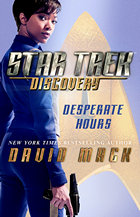 Desperate Hours is the first novel under the Star Trek: Discovery imprint, and sees the reliable Trek author David Mack with the unenviable task of tying the backstory of Discovery with the elaborate Star Trek novel continuity. From the get go, this was going to be a difficult task, and to his credit, Mack, under direction from Bryan Fuller, goes straight in there by setting this story at the exact intersection of the origins of Trek and its newest iteration.
Desperate Hours is the first novel under the Star Trek: Discovery imprint, and sees the reliable Trek author David Mack with the unenviable task of tying the backstory of Discovery with the elaborate Star Trek novel continuity. From the get go, this was going to be a difficult task, and to his credit, Mack, under direction from Bryan Fuller, goes straight in there by setting this story at the exact intersection of the origins of Trek and its newest iteration.
Desperate Hours (perhaps the most generic title an adventure story could have) is set in 2255, one year before the fateful events of "The Vulcan Hello," and one year after the very events written for Star Trek, those of the first pilot episode, "The Cage." In spite of being set only two years apart, "The Cage" and "The Vulcan Hello" are worlds apart in content, style and tone, the franchise having developed in such ways that the two episodes are scarcely recognisable as being part of the same universe. Nonetheless, if any medium can make this work, it's prose, as the very distinct visual styles of these two eras of Star Trek can be glossed over, and the business of story focussed on.
There's a clear opportunity to combine and contrast characters here, with Starfleet crews from different ends of the franchise coming into collision. A crisis on the breakaway colony of Sirsa III brings both the starships Shenzhouand Enterprise into orbit to deal with the problem. An ancient alien Juggernaut is discovered beneath the surface of the planet, bristling with weaponry and capable of wiping out not only Sirsa but any planet it local space. While Captain Georgiou seeks a solution to both the alien threat and the political ramifications of Starfleet intervention on the planet, Captain Pike is called in to make carry out Starfleet's orders. With the Juggernaut potentially posing a gigantic and uncontainable danger to the Federation, Starfleet order's Pike to lay waste to the planet should no other way of stopping it become apparent.
While it's fascinating to see two captains of very different stripes at loggerheads – Georgiou is methodical and restrained, Pike more bullish and masculine – I struggle to believe that Pike, who was so memorably weighed down with the lives lost under his command in "The Cage," would so readily accept genocidal orders from Starfleet. It's a major failing of characterisation in my opinion, and makes for a significant flaw in the novel.
More successful is the clash between Burnham and Spock. At present there seems to be no plan to bring Spock to the screen in Discovery, in spite of Burnham's relationship with Sarek and her presumed presence during Spock's childhood. Desperate Hours explores Burnham's background, clarifying some confusing elements, including the two traumatic attacks she experienced on Doctari Alpha and Vulcan, and also explores something of her upbringing, with Burnham describing herself as "culturally Vulcan." The similarities between a human, brought up as Vulcan, and a Vulcan-human hybrid, both from the same family, would suggest that Burnham and Spock have a great deal in common and a special bond. So why do Burnham and Spock have so little to do with each other?
To put it bluntly, they can't stand each other. Their ongoing rivalry, competing in youth for the respect of Sarek and the love of Amanda, both trying to prove themselves in a stoic society, has only been exacerbated by Spock's decision to join Starfleet and his resulting schism with his father. Nonetheless, as much as they have a personal dislike for each other, there's a clear and mutual respect between Burnham and Spock, one which sees the upcoming first officer of the Shenzhou call on the junior science officer of the Enterprise for help in this extremely difficult situation. A large chunk of the book is taken up with Spock and Burnham working within the Juggernaut itself, facing a series of deadly tasks. While this leads to some fascinating interaction and sees the two learn more about each other, and so themselves, I have limited patience for narrative that takes the form of a series of puzzles, however life-threatening. Nonetheless, the exploration of both Burnham and Spock brings new depth to both their backgrounds.
The less expected interaction is between Lt. Saru and Pike's Number One, here, in line with other recent novels, given the rather obvious Una. There is further exploration of Saru's background on Kelpia, which explores his nature as a prey animal with less bluntness than the TV episodes, but the surprising part is the deep respect, and indeed attraction, to Number One. The two make an unusual but effective pairing, and their scenes together are some of the most successful in the book.
There is some exploration of the rest of the Shenzhou's bridge crew, giving a richness and realness that was missing in Discovery's pilot story. On the whole, the storyline is an enjoyable adventure, as much about human conflict as alien threat. It's quite a straightforward tale, but one with plenty of action and excitement, and in spite of the supposed danger of the Juggernaut, provides a surprisingly low-key series of events for the first Discovery novel. Then again, not every Starfleet intervention leads to interstellar war, thankfully. This time, Shenzhou and Enterprise come together and chalk this one up as a win for Starfleet. They should probably make the most of it.
- Remarkable civilisations:
- In line with recent novels, Lt. Commander Una hails from Illyria, a Federation colony where the human population have taken on an almost Vulcan poise and restraint.
- The Turanians ruled an empire in this region of the Galaxy nine million years ago.
- Kelpiens inhabit cave systems on their homeworld, to avoid predators.
- Remarkable uniforms: The very different styles of Starfleet uniform seen in Discovery and "The Cage" are explained here: Starfleet has apparently introduced a new style of uniform specifically for the use of its flagship crews on the Constitution-class starships.
David Mack, Star Trek: Discovery: Desperate Hours, Pocket Books, 2017.
ISBN: 1501164570
Star Trek Discovery: Drastic Measures
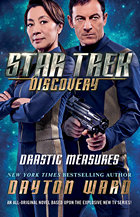 "The Conscience of the King" has long been a fan favourite episode, one that revealed a dark chapter in Star Trek's future history. Back in the first season of Star Trek, when the characters and setting were still being developed, it wasn't so incongruous. A famine followed by a massacre, on a colony planet, witnessed by a young James Kirk, stands out more now as a bizarre and unimaginable event in Federation history.
"The Conscience of the King" has long been a fan favourite episode, one that revealed a dark chapter in Star Trek's future history. Back in the first season of Star Trek, when the characters and setting were still being developed, it wasn't so incongruous. A famine followed by a massacre, on a colony planet, witnessed by a young James Kirk, stands out more now as a bizarre and unimaginable event in Federation history.
After Desperate Hours, a second Discovery novel exploring familiar elements of the Trek universe is an unsurprising move. This book, though, explores a major, known event in future history, rather than dropping the Enterprise crew into a prequel adventure. Desperate Hours takes place in 2246, before even the events on the Shenzou seen in the flashback scenes in Discovery. Philippa Georgiou is serving as first officer on the support vessel the USS Narbonne, while Lt. Cmdr Gabriel Lorca is stationed on Tarsus IV itself.
The setting of the series allows to us explore this event through the eyes of now familiar characters. Interestingly, Kodos's massacre occurs early in the book, in a sequence that is chilling for just how matter-of-fact its telling is. Georgiou only hears about events second-hand, the Narbonne already en route to Tarsus, the very ship that makes the massacre entirely unnecessary. Lorca, however, is in the thick of it. He is in a relationship with a colonist, deeply involved with life on the planet, and witnesses the broadcast of the terrible "solution." While Georgiou's horror is humanitarian, Lorca's is personal, and this affects how they deal with the aftermath of the incident.
Nonetheless, focusing on Lorca is potentially a mistake. After all, this is not the character we've been following on Discovery, for that was the Lorca of the Mirror Universe. This is the "Prime" Lorca, therefore a character new to us, and the exploration into his character is less significant because of that. For what it's worth, Lorca seems to be an aggressive hothead in this universe too, so his Mirror counterpart can't have had too much difficulty taking his place. (It's also very much a Discovery novel in that there's a lot more swearing than we're used to from Trek lit.)
The more interesting scenes are those involving Kodos (who, to maintain continuity, keeps to the shadows throughout and is not seen by any of the major characters. He also has his records thoroughly wiped). Initially troubled by self doubt, his resolve that he made the right decision only grows stronger as he and his followers go into hiding. He's a fascinating character, and his position, at least to begin with, is purely logical. This isn't the first Trek novel to delve into the background of the Tarsus IV Massacre, but it goes into a depth not really seen before. It's easy to see Kodos here become the tired old man of the original episode. Satisfyingly, there are clear causes for the famine, something that should be unthinkable in the Federation; a chain of events leading to catastrophe.
There are some interesting supporting characters, including the governor of Tarsus, Gisella Ribeiro, who is briefly usurped by the more charismatic Kodos, and Captain Korrapati, a dignified older Indian gent (well, Martian-Indian), who commands the Narbonne. Naturally, there are familiar characters as well, including Thomas Leighton, and inevitably, a spunky young man named James Tiberius Kirk. Less expected is an appearance towards the end of the book of the first captain of the Enterprise, Robert April. Appropriately, this is a very human-centred book, in a way Star Trek has rarely been since the first season of TOS, with very few alien characters.
Dayton Ward's prose is as easy to read as ever, but the story sadly failed to carry me along this time. By featuring the massacre early on and focusing on its aftermath, it peaks to early, and what remains is an awful lot of running around, fighting and sabotage, as Lorca and Starfleet attempt to track down Kodos, a mission we know is doomed to failure. The action sequences are perfectly competent, but they're just not as interesting as the psychological and historical elements of the book. Still, this is a worthwhile exploration of a critical moment in Star Trek's mythology.
- Remarkable title: The title of the novel is based on a quote from "The Conscience of the King": "The revolution is successful, but survival depends on drastic measures. Your continued existence represents a threat to the well-being of society." Kodos's speech is included in full in the novel.
- Remarkable aliens: The Betazoids have only recently joined the Federation, and their telepathic abilities are not yet widely known. Denobulans can live for up to 300 years. The presence of a Lirin in a later-set scene suggests continuity with the Early Voyages comic series.
- Remarkable epilogue: Given that Dayton Ward has worked with Kirsten Beyer to maintain continuity with the TV series, the epilogue may provide a very strong hint that a character in this book will appear in season two.
Dayton Ward, Star Trek: Discovery: Drastic Measures, Pocket Books, 2018.
ISBN: 978-1501171741
Star Trek Discovery: Fear Itself
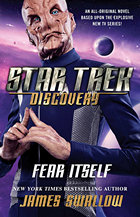 Saru was, for many, the most interesting character in Discovery's first season. A genuinely new and fascinating creation, he stood out in a season that focused on Klingons and Vulcans and other familiar inhabitants of the Trek universe. Much of this was down to the performance of Doug Jones, but the concept of Saru and the writing of his character was just as important. It's no surprise, then, that the third Star Trek: Discovery novel features the Kelpien as its primary protagonist.
Saru was, for many, the most interesting character in Discovery's first season. A genuinely new and fascinating creation, he stood out in a season that focused on Klingons and Vulcans and other familiar inhabitants of the Trek universe. Much of this was down to the performance of Doug Jones, but the concept of Saru and the writing of his character was just as important. It's no surprise, then, that the third Star Trek: Discovery novel features the Kelpien as its primary protagonist.
Many alien races in Star Trek are personifications of human traits. While they still have personalities and, when written well, distinct and complex characters, individuals of these races still embody these traits. Vulcans are logical and oppressed. Ferengi are greedy and opportunistic. Bajorans are spiritual and proud. Now we have Kelpiens, who are frightened. Despite its simplicity, it's a difficult concept to make work, and could so easily make for an unbelievable character who simply panics at every unexpected event. The sort of character who couldn't possibly make a credible Starfleet officer.
Fear Itself takes as its starting point the question: what would it be like to exist in that constant state of fear? How could that come about, and how would it manifest? How could someone live with it? James Swallow, one of the best of the Star Trek authors, gives us a fascinating exploration of Saru's character, looking at both how he is a typical Kelpien, and how he is different from the rest of his people. Much of the novel is told from Saru's perspective, and those scenes where he's absent involve other characters, mostly his colleagues, speculating on what makes him tick.
Saru is revealed to be an even more fascinating individual than he appears onscreen. In a permanent state of near terror, his nature could be a great weakness, but he turns it into a strength. He is revealed as someone who has honed his instincts to remarkable acuity. We learn that Kelpiens possess an electromagnetic sense, allowing Saru to perceive an aura around each being he meets. Saru is someone who is hyper-aware of everyone and everything around him, all the time.
We have some interesting insights into Saru's life before his rescue by Starfleet, but overall we get very little information about his homeworld (here named as Kaminar), probably because the showrunners are planning a visit to the planet in the new season. Most of the exploration, however, is of his time aboard the Shenzhou, and his unique approach to his duties. As well as a strength, it is made clear to him that his cautious nature is holding him back. He puts himself under constant scrutiny and compares himself to his crewmates, particularly the equally analytical but more headstrong Michael Burnham.
It's easy to see Saru's character as a metaphor for someone living with chronic anxiety, but in a high-functioning, proactive lifestyle. Fear Itself sees the Kelpien set out to prove himself when confronted with a delicate but clearly unethical situation, during which time he makes huge mistakes but learns just how to be the officer he knows he can be. It's to Swallow's credit that the novel is both an in-depth character study and a pacy, fun space adventure.
The novel's official blurb makes it clear it's all about Saru. What is unexpected is just how much of the established Trek universe it explores. The Shenzhou stumbles across a ship in distress, revealed to be from Peliar Zel. The Peliar, who were Federation members by the time of their television appearance in TNG: "The Host," are here proudly independent, and only beginning their negotiations with the UFP. Aboard the ship are Gorlan refugees, a complex nomadic species with a truly unique society. The Gorlans are a perfect example of taking a tiny piece of Trek lore – a one-line mention in TOS, and in the Mirror Universe at that – and using it as a starting point to create an intriguing new element. Described as rather burly humanoids with four arms – I was put in mind of the Mystics from The Dark Crystal – the Gorlans have a difficult to translate language that Saru is uniquely equipped to decipher. His insight into their situation sparks an intervention that has huge knock-on effects. There are no obvious villains among the Gorlans or Peliar; everyone has a perspective that is understandable and relevant. To make matter worse, Peliar space is on the edge of Tholian territory, and their presence hangs over the narrative like a storm cloud.
In spite of featuring so much established Trek lore, Fear Itself feels original and inventive. We get some much needed exploration of the Shenzhou's crew, giving us more insight into Captain Georgiou and introducing new characters who become an important part of Saru's world. It's Saru who is the hero, though, and it's here that we can see the beginnings of his rise to command that we see in Discovery's first season. A must-read for anyone who enjoyed that series.
- Remarkable biology: Saru has a sensory organ on the roof of his mouth, that can detect the scent of predators.
- Remarkable civilisations:
- The Gorlans communicate through a combination of words and electromagnetism.
- In the Peliar nation, inhabitants of Alpha Moon consider those of Beta Moon soft-hearted, while Betans consider Alphans aggressive.
- The Tulians, like Lt. Troke, are closely related to the Bolians, but enhance themselves with cybernetic implants.
- Remarkable technology: The Peliar defend their ships using automated weapons drones.
- Remarkable author: James Swallow is a prolific writer of tie-in material, and is one of only a handful of writers to have contributed to both Star Trek and Doctor Who. He is also the only British writer to work on televised Trek: he created the original concepts for the Voyager episodes "One" and "Memorial."
James Swallow, Star Trek: Discovery: Fear Itself, Pocket Books, 2018.
ISBN: 978-1501166594
TOS and Movie Era
Spock Must Die!
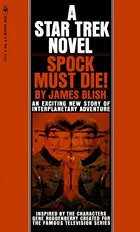 The Klingons have launched a surprise attack against the Federation across a wide front, scoring numerous early victories and knocking Starfleet on its heels. Enterprise is light years away from the action and Kirk decides to head to Organian homeworld to discover why the immortal beings have allowed the war to start (For those of you who may be ignorant, the Organians ended a war between the Klingons and Federation in the episode "Errand of Mercy". You're welcome.). A trip of six months, Kirk despairs that the war may be over before they can arrive, but Scotty proposes a solution; create a duplicate person with the transporter, employing tachyons, and beaming that person to Organia! Spock is the logical choice, but of course things go wrong and a duplicate of the first officer is created on the transporter pad. Who is the other Spock? Which is the real one? What is his relation to the growing crisis, and does the duplicate mean Enterprise harm?
The Klingons have launched a surprise attack against the Federation across a wide front, scoring numerous early victories and knocking Starfleet on its heels. Enterprise is light years away from the action and Kirk decides to head to Organian homeworld to discover why the immortal beings have allowed the war to start (For those of you who may be ignorant, the Organians ended a war between the Klingons and Federation in the episode "Errand of Mercy". You're welcome.). A trip of six months, Kirk despairs that the war may be over before they can arrive, but Scotty proposes a solution; create a duplicate person with the transporter, employing tachyons, and beaming that person to Organia! Spock is the logical choice, but of course things go wrong and a duplicate of the first officer is created on the transporter pad. Who is the other Spock? Which is the real one? What is his relation to the growing crisis, and does the duplicate mean Enterprise harm?
At a lean 118 pages, Spock Must Die(!) is a fast moving story that, well, isn't bad. Perhaps I am spoiled by the Star Trek novels I have read over the past few decades, but I felt James Blish did not take full advantage of the medium. The book resembles a television episode in the worst way, in that Uhura, Sulu and Chekov are given precious little to do in comparison to Bones, Spock, Kirk and Scotty. Months of travel time pass in the novel and yet any attempt to flesh out characters normally given short shrift on the television series are largely overlooked. Perhaps Blish was attempting to capture the feel of the series, telling a focused tale rather than deviating with character moments. Whatever his reasons I feel the book suffers for a lack of those humanizing elements. However, in the later chapters Blish takes full advantage of the medium, creating fantastic situations where Kirk's perceptions are challenged on the surface of Organia, scenes which would have been impossible to render on a sixties television series. While today transporter accidents and evil twins have become something of a cliché, at the time Blish penned the book the concepts were still novel, so it would be unfair to hold it against James for employing them here. Besides, I found "evil" Spock to be quite interesting.
In the end I can only give Spock Must Die(!) a mild recommendation; it's not a bad story and James Blish is a solid writer, and I found it interesting from a historical point of view, but I have read far better Star Trek novels over the years. If you have a chance to track the book down and you have some free time (and considering how small the book is you won't need much), and if you are curious about this particular portion of Star Trek history, I suggest you give it a look.
(Thomas Stockel)
James Blish, Spock Must Die!, Bantam Books, 1970.
ISBN: 0553107976
The Three-Minute Universe
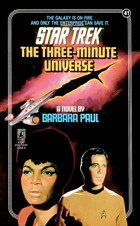 "The Sackers. In all Captain James T. Kirk's travels, he has never found a race more universally shunned and abhorred. Their mere appearance causes most Federation members to become violently ill. Now the Sackers have performed a deed whose brutality matches their horrifying exterior."
"The Sackers. In all Captain James T. Kirk's travels, he has never found a race more universally shunned and abhorred. Their mere appearance causes most Federation members to become violently ill. Now the Sackers have performed a deed whose brutality matches their horrifying exterior."
Doesn't sound very Star Trek does it? A race of monsters who act as badly as their appearance suggests? However, Barbara Paul's only Star Trek novel is, in fact, very true to the spirit of Trek and its lesson of tolerance for all peoples. It does, though, accept that some races and cultures are going to have a harder time getting along than others. The Sackers are feared and loathed throughout the Federation due to their physical attributes, which makes them not only deeply unpleasant to be around, but actively dangerous for most humanoid species.
Realistically, this is more likely what we will find should we travel among the stars, rather than planet after planet of human-like aliens. We should expect alien life to have adapted to wildly different environments and followed different evolutionary paths, and yes, some of them will be very hard for us to stomach. Many people can't deal with maggots, slugs or spiders, and they're products of the same world and evolutionary tree as us.
Even Kirk struggles to cope with even an image of a Sacker, something he feels quietly ashamed of. Other characters display open contempt for the aliens, particularly once their actions become clear. The novel opens with the destruction of a star system by an unprecedented wave of thermal energy, which is revealed to be the front of an expanding infant cosmos – the Three-Minute Universe of the title. This phenomenon has been allowed into our universe by the Sackers for reasons unknown, and threatens the entire galaxy should it be left to expand.
The threat of fire is a theme throughout the book, sometimes rather unsubtly. It turns out that Uhura lost a friend in a fire as a child and has been haunted by nightmares of it ever since. This isn't something that was ever hinted at on screen, but provides a new dimension to her character by giving her a potent fear to overcome during the episode. Faced with a fire of cosmic proportions, and aliens who exist at burning hot temperatures, Uhura's pyrophobia threatens to get the better of her.
Throughout, the core characters are portrayed well, with affection and humour. This feels late in the Five Year Mission, with a strong camaraderie between the crew. We gain a good insight into Kirk's way of captaining, Scotty's love for his work, and even the emotions that run beneath Spock's restrained persona. Even the sudden revelations about Uhura's life work with strong characterisation that makes her immediately recognisable. Only Bones seems out-of-sorts, being even more pessimistic than usual, but then, the entire universe is under threat, so we'll forgive him that.
Investigations into the Sacker threat takes the Enterprise to the planet Holox, where further atrocities come to light, before Kirk, Uhura, Scotty and Chekov are abducted and taken aboard the aliens' gigantic starship. Being in the direct presence of so many Sackers is almost intolerable to begin with, but the aliens provide life support equipment for them and cover themselves up, and use translators to make themselves understood. In an unexpected twist, they put Kirk and his colleagues to use as instructors, being junior crewmen who were left in charge of the mission when a disaster killed the bridge crew.
This allows Kirk and co. to sow the seeds of dissent and disillusion, but in doing so, they come to know, understand, and even like their repulsive captors. Underneath it all, the Sackers are scared, driven by their desire to complete a last desperate mission to hold to ransom a universe that has rebuked them. The aliens become very sympathetic, as we understand what it must have been like to be turned away every time they tried to make peaceful contact. A quirk of their culture means that Sackers aren't given names for some time, and these Sackers have been left nameless, only to take whatever names Kirk and crew give them. As such, their leader ends up being called Commander Babe after an off-the-cuff word of Kirk's, and that's one of the less ridiculous monikers.
Paul's great sense of humour makes the more unsettling elements of The Three-Minute Universe easier to swallow, but the core message is a serious one. Sometimes different cultures find it very hard to tolerate each other, but underneath, our fundamental needs, joys and fears are the same. For an outlandish sci-fi story about hideous alien monsters, it's really rather beautiful.
- Remarkable civilisation:
- The Sackers: So-called by the Federation due to the rugose membranous sac that covers their body. The sac is translucent so that the internal organs can be seen within a dense fluid, within which, white, wormlike things can be seen moving around, acting as messenger organs. The overall effect to a humanoid is that the Sacker body appears to be rotting. The Sackers also smell so overpowering that they make a humanoid sick in moments, emit and require such heat that brief contact with human skin delivers serious burns, and speak with such volume and pitch as to be deafening. They are, however, highly intelligent and individualised beings, if you can stand them long enough to get to know them.
- Zirgosians: Ordinary humanoids from the Beta Castelli system, who also colonised the planet Hylox. Highly technologically advanced, they are Federation members, although clearly keep mostly to themselves.
- Gelchenites: Stocky, powerful humanoids with virtually no-neck, hailing from a heavy-gravity planet.
- Remarkable author: Barbara Paul is best known for her crime novels such as Your Eyelids Are Growing Heavy and Full Frontal Murder, which she often peppered with science fiction references.
- Remarkable quote: "Y'see, the frammistan redirects the betagrams through an ion-free calcimogrifying chamber, where they're mixed by the glockenspiel to regurgitate with zeta-minor demi-prostulances. Then the new mix spurts through the Fallopian tube into the Loch Lomond antimasticator – and ye know what that means, don't ye?" - Scotty gives an engineering version of the Fizzbin rules.
Barbara Paul, The Three-Minute Universe, Pocket Books, 1988.
ISBN: 0671658166
Star Trek: Death Count
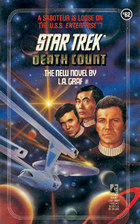 In this complex novel the crew of the Enterprise have to deal with trigger-happy Orions, angry Andorians, a mysterious scientist, annoying auditors, a saboteur, and a lily pond.
In this complex novel the crew of the Enterprise have to deal with trigger-happy Orions, angry Andorians, a mysterious scientist, annoying auditors, a saboteur, and a lily pond.
The good and the bad about Death Count is summarized quickly. It is remarkable that Kirk appeared only infrequently, and that Spock and McCoy were even limited to a few sentences in the entire book. I was pleased that Sulu, Chekov and Uhura are the main characters and the novel is told from their perspectives. It is credibly shown that they can do more than utter an occasional "Yes, sir" and that they have a private life beyond their daily duties.
L.A. Graf successfully recreate the atmosphere of the Movie era and carefully supplement it with new ideas. One problem I noticed is that the novel tries hard to resolve its own complexity, similar to a novel by Agatha Christie. I have the impression that the authors or I myself failed to tie together a few of the loose ends. There are just too many different characters and events that require attention. A few less conflicts and explosions may have suited the story better, and could have rendered it more plausible.
Overall, it is an enjoyable but rather not one of the most exciting Star Trek novels.
L.A. Graf, Star Trek: Death Count, Pocket Books, 1992.
ISBN: 0671793225
Star Trek Vanguard: Harbinger
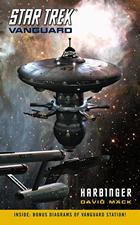 This is the first book in a new series by David Mack about a space station at the Federation frontier. They year is 2265. The USS Enterprise has just returned from her first voyage under Captain James T. Kirk. In the tradition of spin-offs on screen and in print David Mack draws on well-established characters to introduce a new setting. This strategy works out for the Vanguard series, although I have the impression that the Enterprise should have been involved either somewhat less (just enough to demonstrate "this is the TOS era") or considerably more (as we can hardly visualize Kirk and his crew in secondary roles). Anyway, the depiction of the Enterprise crew is accurate and respectful.
This is the first book in a new series by David Mack about a space station at the Federation frontier. They year is 2265. The USS Enterprise has just returned from her first voyage under Captain James T. Kirk. In the tradition of spin-offs on screen and in print David Mack draws on well-established characters to introduce a new setting. This strategy works out for the Vanguard series, although I have the impression that the Enterprise should have been involved either somewhat less (just enough to demonstrate "this is the TOS era") or considerably more (as we can hardly visualize Kirk and his crew in secondary roles). Anyway, the depiction of the Enterprise crew is accurate and respectful.
Regarding the new characters, composed of the Vanguard crew and miscellaneous alien and non-aligned people, my apprehension is that they are too much of a mixed bag for a whole series of novels, as they are likely to get in touch only infrequently - unlike it would be among a starship crew. So far T'Prynn, the Vulcan who holds a secret, and Tim Pennington, the ambitious reporter, strike me as the most interesting figures. On the downside, Cervantes Quinn, the likable rogue in the tradition of Harry Mudd and Cyrano Jones, and Anna Sandesjo, the surgically altered infiltrator, appear too conventional to me. The perhaps most important role is taken by the station itself, designed by Masao Okazaki. The fold-out with the station's diagrams is a highlight of the book. David Mack shows a good sense of incorporating Vanguard's spacious interior its into the story, unlike in other novels where time and especially space are not particularly important, but without digressing to technical trifles like it is so often in fan fiction.
The novel is pleasant reading and it thrives on its intense and almost beautiful language, although the contrast between narration and spoken dialogue is a bit harsh at times. I may be spoiled by the TV incarnations. Yet, the language as well as the manners in TOS used to be somewhat different. The same goes for the depiction of bloodshed and sex which naturally had to be toned down in the 1960s. The love triangle in this novel would not have been possible in the time of TOS, and it only adds realism (but isn't it a waste that it ends very soon after the death of a character?). The amount and explicitness of violence, especially regarding Quinn and the Orion Ganz, is a tad too much, however.
A slight letdown of the book lies in its nature as a part of a series. After 374 pages full of action and intrigue almost nothing of the mystery is solved. The novel is neither boring in any way nor would it suffer from the open end, still with a bit more of a conclusion it could have been perfect.
David Mack, Star Trek Vanguard: Harbinger, Pocket Books, 2005.
ISBN: 1416507744
Star Trek: The Original Series: The Latter Fire
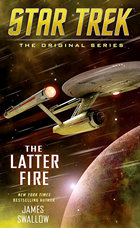 The Latter Fire centers around a diplomatic mission to Syhaar Prime, which was precipitated by an encounter with a Syhaari starship the previous year. However, recent advances in Syhaari technology lead Kirk to believe that the Enterprise crew may have inadvertently leaked technological information during first contact.
The Latter Fire centers around a diplomatic mission to Syhaar Prime, which was precipitated by an encounter with a Syhaari starship the previous year. However, recent advances in Syhaari technology lead Kirk to believe that the Enterprise crew may have inadvertently leaked technological information during first contact.
This novel begins with the classic Star Trek conundrum: did a Federation starship accidentally contaminate a culture in violation of the Prime Directive? However, drastic twists soon occur, and the plot delves from a "TNG-style" first contact mission into the realm of a gripping TOS thrill ride. James Swallow expertly weaves both styles together effortlessly, and the result is sure to satisfy diplomatic enthusiasts and action junkies alike.
Surprises abound in the intricate plot, and I would be remiss to spoil them for the reader. Political intrigue, new alien species, and interesting revelations proliferate The Latter Fire, and one could easily envision this novel being a dramatic two-part episode of The Original Series. I highly recommend The Latter Fire to anyone looking to delve into the world of classic Star Trek and Kirk's five-year mission.
(Jay Stobie)
James Swallow, Star Trek: The Latter Fire, Pocket Books, 2016.
ISBN: 978-1476783154
Star Trek: The Original Series: The Face of the Unknown
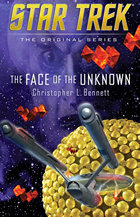 Of all the alien civilisations introduced in TOS, the First Federation is perhaps the most intriguing. The gigantic starship Fesarius, commanded by Balok, seemingly by a ghoulish alien creature, before being revealed as a tiny, childlike being, all alone on his huge ship. Was the First Federation as powerful as it appeared? Or was it all smoke and mirrors, like the puppet Balok used to strike fear into the Enterprise crew?
Of all the alien civilisations introduced in TOS, the First Federation is perhaps the most intriguing. The gigantic starship Fesarius, commanded by Balok, seemingly by a ghoulish alien creature, before being revealed as a tiny, childlike being, all alone on his huge ship. Was the First Federation as powerful as it appeared? Or was it all smoke and mirrors, like the puppet Balok used to strike fear into the Enterprise crew?
It seems strange that we never saw the First Federation again. Part of this might be down to the word Federation becoming the name of the primary setting some episodes later, and a simple desire to avoid confusion. On the other hand, perhaps the writers simply never wanted to bring them back, in TOS or any of the sequel series. Even the novel range has barely featured Balok and his people, and the nature of the First Federation remains a mystery.
In The Face of the Unknown, Christopher Bennett rectifies that by taking us into the heart of the First Federation. Taking place between TOS and TAS, at the opposite end of the Five Year Mission to first contact between the two Federations, the novel presents a vision of an ancient, secretive civilisation hidden within the Alpha Quadrant. Bennet has form with this sort of thing; his Trek novels are full of archaic societies, exotic environments and non-humanoid species. So it is with the First Federation. A collective of alien races, of which Balok's people, the Linnik, are the most human-like, who hid from their enemies 12,000 years ago. They now exist in the Web of Worlds, a gigantic construct of various environments deep within the atmosphere of a jovian planet. It's a breathtaking visual, one that is screaming out to be visualised onscreen, and a far cry from the usual Class-M planets we see in Star Trek.
The sudden reestablishment of contact with the First Federation comes about due to sudden attacks on ships in a disputed sector, perpetrated by a malicious alien race. It turns out that the Linnik have secrets even from the rest of the First Federation. The puppet used by Balok to frighten outsiders supposedly represents a sort of bogeyman from his culture, but it turns out that there is more to the creatures than mere myth. The presence of the Enterprise acts as the catalyst that reveals the nature of the marauders and their relationship to the Linnik, but also sets off a cataclysmic crisis on the Web of Worlds.
Bennett has a fine grasp of the characters of TOS, in particular Kirk and Spock. He enjoys adding, at the very least, a hint of romance to the story, with both Spock and Kirk getting some attention – par for the course for Kirk, but this time with a far less humanoid lady than usual. Sulu and Chekov also get some very heroic moments on the Web of Worlds. Outside the regular characters, it's a pleasure to get to know both Balok and young ambassador to the First Federation, Mr. Bailey, both of whom achieve more depth here than in their screen appearance. An enjoyable adventure that provides much needed exploration of a forgotten corner of the Star Trek galaxy.
- Remarkable title: The title of this episode comes from Kirk's line to Bailey in "The Corbomite Maneuver": "The face of the unknown. I think I owe you a look at it." It also refers to both the peoples of the First Federation and Dassik.
- Remarkable reworking: This novel was originally planned as part of the Star Trek: Titan series, with flashbacks to the TOS era. It was then reworked to be set on Kirk's Enterprise, but during the movie era, before Bennett settled on a setting at the end of the Five Year Mission. Bennett also worked in material from his unpublished Kelvin-verse novel, Seek a Newer World.
- Remarkable aliens: The Linnik are a neotenous species, never developing physically beyond the childhood stage, but blessed with great intelligence.
- Remarkable ship: The Fesarius and its sister vessels are designed as mining ships, their huge size mostly empty space for mined material and cargo.
Christopher L. Bennett, Star Trek: The Face of the Unknown, Pocket Books, 2016.
ISBN: 1501132423
Star Trek: The Original Series: The Captain's Oath
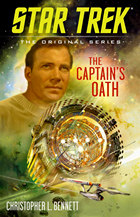 The popular image of James T. Kirk is greatly at odds with the character as originally conceived and presented. The idea of Kirk as a galactic lothario, a maverick captain with no respect for the rules is one that evolved out of the later episodes and films, further embedded in the public consciousness by many parodies. The version of Kirk we meet in the Abramsverse movies – womanising, rebellious, disrespectful and unrepentant – is a world away from the youthful Kirk we heard about in the first season of Star Trek, a studious, rule-bound young man who was still quite restrained even when he took command of the Enterprise. Amusingly, the Abramsverse version of Kirk is far more like Picard was at the Academy than the Cadet Kirk of the Prime timeline.
The popular image of James T. Kirk is greatly at odds with the character as originally conceived and presented. The idea of Kirk as a galactic lothario, a maverick captain with no respect for the rules is one that evolved out of the later episodes and films, further embedded in the public consciousness by many parodies. The version of Kirk we meet in the Abramsverse movies – womanising, rebellious, disrespectful and unrepentant – is a world away from the youthful Kirk we heard about in the first season of Star Trek, a studious, rule-bound young man who was still quite restrained even when he took command of the Enterprise. Amusingly, the Abramsverse version of Kirk is far more like Picard was at the Academy than the Cadet Kirk of the Prime timeline.
With The Captain's Oath, Christopher L. Bennett provides his own account of Kirk's early time as a starship captain. It's far from the first such attempt; aside from the 2009 movie's alt-timeline version, there's Enterprise: The First Adventure by the late Vonda McIntyre and various flashbacks in the comics over the years. Still, it's an under-explored part of Star Trek's history, and Bennett provides what might be considered the definitive version, at least as far as the literary continuity is concerned.
Rather than focus on one particular mission, Bennett provides an array of adventures from Kirk's early career, all of which shape him into the man we see in "Where No Man Has Gone Before" and Star Trek's first season. Some of these – such as the rescue of the pre-warp Chenari people from imminent extinction – we've heard of before in passing. Others are entirely new inventions by the author. The novel is split into three main timeframes, covering Kirk's first command posting on the USS Sacagawea, a planetside posting and return to the Sacagawea and his eventual award of the command of the Enterprise. The story jumps back and forth between these timeframes, with the consequences of events sometimes being revealed before the events themselves. It's a deftly plotted book, and Bennett handles the multiple storylines well. He makes it look easy, which is the mark of true skill.
We meet various characters, both recognisable and new. It must have irresistible to portray the first meetings between Kirk and McCoy, Spock and Sulu. They feel at once momentous, due to what we know of the characters' futures, and ordinary, just another day on the job. We know what's coming, but the characters don't. Their storied futures are still to come. We also get to spend a great deal of time with Gary Mitchell, a character who is far more like the clichéd version of Kirk than the man himself. Of the original characters, my favourite is Rhenas Sherev, an Andorian archaeologist and long-time friend of Kirk, who recurs throughout the novel's different timeframes. She's a strong-willed, stubborn character who bucks authority when she's got a personal mission to complete.
Kirk's various missions give the novel a real sense of adventure. There are clashes with Klingons, first contacts and diplomatic overtures. Again, some of these involve elements fans will recognise – the early negotiations with the Acamarians from "The Vengeance Factor", for example. Others are wholly new, included an ingenious sidestep to the planet Nacmor, a world at a 20th/21st century level of development where fictitious alien invaders are being used to keep the populace in line. Along with a later storyline involving the Aulacri, the problem of misinformation, whether it's withholding facts from the people or all-out "fake news" is a running theme.
There's one plot thread that runs throughout the novel, impacting multiple worlds. Without wanting to go into too much detail, because the fun is in discovering the truth along with the characters, it involves a new alien race that are novel in conception, and potentially pose a major threat to the Federation. As is often the case, though, things are not as they seem, and again Bennett uses a sci-fi setting to discuss the problem afflicting the USA and the world at large today. Exactly what Star Trek should be doing.
Throughout the novel, Kirk learns some sober lessons about command, learning when to follow orders, when to protest, when to stick to his guns, when to let others change his mind. He becomes less rule-bound, more willing to bend the rules or even break them, but only when it's the right thing to do. We see the impact his more relaxed friends and colleagues have on him, but never does he stray from the truer representation of the character that Bennett is striving to recreate.
Like much of Bennett's work, there's a clear intention to fill the gaps in Star Trek's history. Along with the many references and appearances by familiar elements, it steers close to fanwank, but the overall impression is that Bennett is someone who has really thought about this fictional universe and how it could work. For all the intellectual exercises and introspection in this novel, it's also tremendous fun.
- Remarkable starship: The USS Sacagawea NCC-598 is a Hermes-class scout ship.
- Remarkable officers: Kirk's two first officers on the Sacagawea are a Rigellian named Egdor, and then a human named Adebayo.
- Remarkable star system: The Regulus system contains four inhabited planets and a gas giant with an inhabited moon. Species that have colonised it include humans, Vulcans, Rigellians, Caitians and Arodi.
- Remarkable continuity patch: The Delta Vega Mining Consortium is a neat way to suggest a possible explanation for two completely different planets with the nonsense name Delta Vega. It's not elaborated on in the book, but Bennett's notes suggest they're just the first part of catalogue names for planets supporting mining stations.
Christopher L. Bennett, Star Trek: The Captain's Oath, Pocket Books, 2019.
ISBN: 1982113294
Star Trek: The Original Series: The Higher Frontier
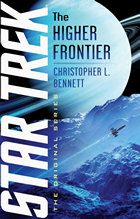 Christopher Bennett continues to plug the gaps in the Original Series timeline, having explored the all the way from Kirk's first command through to the aftermath of "Star Trek: The Motion Picture" in his previous works. The Higher Frontier takes place in the hinterland between TMP and "The Wrath of Khan". Like his previous novel The Face of the Enemy (which returned to the First Federation), this latest work explores previously seen but mysterious alien races.
Christopher Bennett continues to plug the gaps in the Original Series timeline, having explored the all the way from Kirk's first command through to the aftermath of "Star Trek: The Motion Picture" in his previous works. The Higher Frontier takes place in the hinterland between TMP and "The Wrath of Khan". Like his previous novel The Face of the Enemy (which returned to the First Federation), this latest work explores previously seen but mysterious alien races.
The novel brings back Miranda Jones and her Medusan symbiote Kollos, who joined together at the close of "Is There in Truth No Beauty?" The story explores the effects of this union on both Jones and Kollos, while taking a welcome look at the Medusans, one of the most fascinating alien species created for the Original Series. At the same time it brings the Aenar into the 23rd century, looking for a reason why they disappear from Federation affairs thereafter, and also taking time to delve into their culture. The two alien races are an obvious pairing, in hindsight: the Aenar are blind and telepathic, while the Medusans communicate entirely through telepathy and can drive anyone who sees them to madness. They compliment each other perfectly
There's a great deal of focus on Dr. Jones, a unique character in the franchise, as she learns about herself and also develops a relationship with Admiral Kirk. It's gratifying to see that Bennett disliked Kirk and the other male officers' treatment of Jones in the original episode, in which they were, by modern standards, appallingly laddish and chauvinistic. He has Kirk apologise to Jones, and the more mature version of the character from the films makes for a good romantic foil, even if we know from our vantage point that it can't last.
There's plenty of exploration of other familiar characters as well. The camaraderie between Sulu, Uhura and Chekov is a highlight, even as the latter begins his posting on the USS Reliant. Seeing him develop under Captain Terrell and the Reliant bridge crew has tragic overtones for the reader, knowing as we all do the fate of the ship in "Star Trek: The Wrath of Khan". A very successful character is Thelin, the Andorian officer seen in the alternative timeline of the animated episode "Yesteryear." Here we get to meet the prime timeline Thelin, who acts as a bridge between the Andorian and Aenar and our window into the difficult relationship between the two cultures. (Thelin's greyish skintone on the cartoon is explained away by his having an Aenar grandparent.)
The Higher Frontier is a sweeping exploration of psychic phenomena during the 23rd century, when human espers were surprisingly well-known in the Federation. This goes right back to the second pilot episode, and the known existence of human beings with psychic abilities is an oddity in the Original Series that doesn't appear in other parts of the franchise. Dr. Jones, who becomes something of a figurehead for telepaths throughout the Federation, is only the most powerful of the human espers. Bennett brings in the New Humans – a movement briefly spoken of in Roddenberry's novelisation of The Motion Picture – and repurposes them as a cultural movement of espers looking to advance their own evolution.
Into this complex universe come the Naazh, a group of brutal, armoured terrorists who lead a campaign of, essentially, ethnic cleansing against "unnatural" psychics, beginning with the Aenar. There's some breathless and surprisingly violent action sequences throughout the book, balancing out the more philosophical side of things. Bennett is a big fan of Kamen Rider, and has peppered the book with references to this series, all of which went over my head, but the idea of the Naazh as tokusatsu-style soldiers is a striking visual. (For most western readers, Power Rangers is probably the most familiar example of this genre.)
Bennett's prose is always a pleasure to read, although on occasions here the exposition does become a little unwieldy, particularly when he's refers back to previous episodes, films and books. I'm not particularly enamoured with his eventual explanation of the espers' abilities. I'm not entirely sure everything in the canon needs to be explained away, and his overarching storyline is a little unwieldy. However, he maintains a thrilling story, bursting with ideas and fascinating visuals, even though the final revelations demand to be taken with a pinch of salt.
- Remarkable species: In line with the Shatnerverse novels and general fan consensus, the Medusans are described as beings of multiple dimensions. This is, at least partly, the cause of their damaging effect on the humanoid psyche.
- Remarkable pseudoscience: Telepathic and telekinetic powers are transmitted by particles called psions.
- Remarkable fiction: Starfleet: The Enterprise Chronicles is the in-universe version of Star Trek itself, and some of the more outlandish tales mentioned here are based on old Trek comic strips. The real crew are suitably baffled by them.
Christopher L. Bennett, Star Trek: The Higher Frontier, Pocket Books, 2020.
ISBN: 198213366X
Star Trek: The Original Series: Living Memory
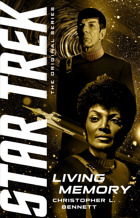 Bennett's ongoing mission to plug the gaps in Star Trek continuity and reopen forgotten storylines reaches what might be its ultimate expression in Living Memory, as he takes on two unrelated elements from Trek's early history that have been largely ignored.
Bennett's ongoing mission to plug the gaps in Star Trek continuity and reopen forgotten storylines reaches what might be its ultimate expression in Living Memory, as he takes on two unrelated elements from Trek's early history that have been largely ignored.
Firstly is one of the original Star Trek's most idiotic plot points. In season two's "The Changeling," the Nomad probe wipes Uhura's memory as it tries to understand her illogical human mind, leaving her with only her basic functional and linguistic skills. The viewer is then expected to accept that Uhura is able to relearn her entire education, skills, training and presumably every event in her life so far. You can't help but feel sorry for Nichelle Nichols as she has to play the now childlike Uhura with a straight face, and the full knowledge that this time next week she'll be all back to normal.
In an otherwise excellent episode, it's a moment that destroys all suspension of disbelief, so it's unsurprising that we never hear of it again onscreen. Bennett, however, takes it as the starting point of a moving character journey, as well as a vital missing piece to the puzzle at the heart of the novel's major threat. Unforeseen phenomena dubbed "vacuum flares" have begun appearing in space, threatening ships and eventually inhabited planets, and the only clue as to their origin is that they appear to be following the route of the USS Enterprise, specifically those planet's where Uhura made planetfall. Her past actions are somehow linked to this new danger, which is a bit of a problem now that she can't remember anything earlier than season two.
Exploring the "in-between" era that links The Motion Picture and The Wrath of Khan, Bennett has provided a great deal of depth to the familiar characters in the past, and this book is no exception. While Uhura's quest to recover her lost memories is essential to solving the plot, but more importantly it's a heartfelt personal mission for her. We have a rare opportunity to learn more about Uhura's life, as she struggles to reconnect with her family, and abandoned friends and lovers, who she no longer remembered and couldn't bear to see before, reminded as she was only of her loss. It's a brilliant way of taking a very silly sci-fi plot point and exploring the actual long-term effect the trauma would have one someone suffering it, something that didn't happen much in the very episodic series itself.
Within this storyline we also have more exploration of Uhura's close relationship with her Enterprise colleagues, who become her replacement family after the memory wipe. She is particularly close to Scotty – who has his own traumatic memories of the Nomad encounter – and to Spock, her commanding officer and something of a mentor in this novel. We also see that she has remained close friends with Sulu and Chekov, although they're both called away on their own work for much of the book. For Chekov, this is investigating the vacuum flares, while Sulu becomes involved with Starfleet security. Admittedly, this does seem like it's the wrong way round.
The second major storyline deals with the Arcturians, an only briefly seen alien species that was created for The Motion Picture and described in background materials as running a clone army. This is, of course, pretty hard to reconcile with the Federation's ethical code, but since it was never mentioned on screen most writers have ignored it altogether. Bennett, instead, tries to rationalise it as a misunderstanding of the Arcturians' elite soldiers, the Warborn, who were genetically engineered centuries earlier and have been kept in stasis since. Now, with the stasis failing, they're being thawed out, and a handful of them are admitted to Starfleet Academy to see if they can integrate and find a new purpose in life.
It's an interesting addition to the wider Trek universe and examines the Federation's supposedly all-inclusive nature. The Warborn's introduction to Starfleet raises a lot of tensions, from peace protesters already concerned with the apparent militarisation of Starfleet, to those in Starfleet itself who worry that the Warborn would be used again in a war setting – or even lead to war by inflaming tensions with the Klingons or Romulans.
The Warborn cadets get their own distinct characters, as do several other new recruits from various Federation races. None of them really stood out for me in the same way as the established Trek characters, although I was taken with Ashley Janith-Lau, a highly intelligent peace activist who forms a relationship with Dr. McCoy. The good doctor and Admiral Kirk are largely confined to Earth in this story, as Kirk is essentially the Warborn's sponsor in the Academy. The tensions rise to the point where a murder is committed and one of the Warborn are suspected. This brings a murder mystery element to the latter part of the book, although it's a little underdone.
The two storylines run in parallel but there's little to link them, although one nice touch is that "Arcturian rapid learning techniques" that are used on Warborn soldiers were also used to help Uhura get back up to speed after the Nomad encounter. There's a lot going on in both storylines at the end of the book, but ultimately it's a little anticlimactic. However, I adored the eventual explanation for the phenomenon that's threatening local space, and Uhura's link to it. Without spoiling it here, I can say that it's ingeniously thought out, and hinges on a truly fascinating science fiction concept that brought some of the greats, like Arthur C. Clarke and Stephen Baxter to mind. Altogether, not the strongest of Bennett's books but still with a great deal to recommend it.
- Remarkable civilisations: The Arcturians have had a love of Shakespeare since their earliest interactions with humanity, and the Warborn take their names from characters from his plays. The cadets include Horatio, Portia, Bertram, Benedick and Viola.
- Remarkable planets: Denobula is one of the first inhabited planets to be affected by the vacuum flares.
- Remarkable ship: When the novel starts, and before she is drawn into the mystery of her own past, Uhura is serving on the USS Asimov.
- Remarkable job: Uhura's mother is a legal representative for African elephants!
Christopher L. Bennett, Star Trek: Living Memory, Pocket Books, 2021.
ISBN 1982165898
TNG Era
Star Trek: The Next Generation: Requiem
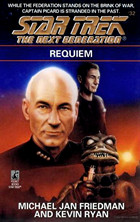 Michael Jan Friedman's prolific Star Trek career had a long focus on the adventures and background of Jean-Luc Picard, in particular his Stargazer series of novels, and both he and Kevin Ryan have worked on material spanning the 23rd and 24th centuries. Unsurprising then that Requiem is a strong Picard story and a diverting TOS-era adventure, if you can swallow the contrived central conceit.
Michael Jan Friedman's prolific Star Trek career had a long focus on the adventures and background of Jean-Luc Picard, in particular his Stargazer series of novels, and both he and Kevin Ryan have worked on material spanning the 23rd and 24th centuries. Unsurprising then that Requiem is a strong Picard story and a diverting TOS-era adventure, if you can swallow the contrived central conceit.
Requiem begins with a flashback to Picard in his Stargazer days, in an early and vital diplomatic meeting with the Gorn. Picard takes charge of the potentially deadly situation with characteristic confidence, paving the way for a conference on Gorn in 2370, the build-up to which forms the initial setting for the novel. However, en route to Gorn space, the captain allows curiosity to get the better of him and diverts the Enterprise to investigate an abandoned alien station boasting incredibly advanced technology. The crew's unfamiliarity with the alien technology, including an astonishingly powerful transporter system, sees Picard beamed through time and space. The novel then splits into two threads, one of which deals with Riker and the Enterprise crew's attempt to rescue Picard in time for the Gorn conference, the other following the captain's experiences in the past.
The contrived part is that Picard is beamed back in time to Cestus III, mere days before the Gorn attack that led into the classic episode "Arena." If you can swallow the enormous coincidence of Picard finding himself at first contact with the very civilisation he is now instrumental in making peace with, then this novel will be a more satisfying read. Personally, I found myself hoping for some kind of explanation, some intelligence at work, rather than a cosmic coincidence.
Nonetheless, this remains an exciting and thoughtful novel, engaging and easy to read. Picard is torn between his commitment to preserving the past and his need to escape and get back to the Enterprise, his intellectual choice to stay remote from the Cestus colony and his personal feelings for the colonists as he inevitable becomes involved. In particular he develops a strong mutual attraction for Julia Santos, the colony's chief doctor, a likeable and well-realised character whom he knows must soon die at the hands of the Gorn. There are some humorous moments – Picard takes on the name "Dixon Hill" while he's stuck in the past, and pretends to be a hardened space trader – but the overall feel is one tense foreboding. Not only does Picard carry enormous guilt for not working to save the colonists, he is painfully aware that his actions could be altering history in catastrophic ways without his even realising. It's rare that we see Picard with such self-doubt.
Self-doubt, of course, is more Riker's thing, on those occasions that his mentor is lost and he is forced to take command. Riker is himself torn, wanting to focus the Enterprise's efforts on both repairing the alien station and locating the captain, but also under intense pressure from Starfleet to get the ship to Gorn in time, lest the fragile peace be broken. Adding an extra dimension is his knowledge that Picard is the only man to make any headway with the Gorn this century, and his worry that if he can't rescue the captain, he'll be unable to salvage the conference. An interesting element is his decision to promote Ensign Ro Laren to temporary first officer, knowing that she's the best choice to keep him on his toes and stand up to him. Indeed, it's Ro's idea to contact a group of Bajoran criminals to help with the search that finally tips the balance in Riker's favour.
There's also some strong focus on Geordi, Data and, in particular, Barclay. Reg is present during a quite horrific accident on the station that claims a crewman's life, and he has a very believable, very human reaction to it. This leads Geordi to consider him unfit for further duty, but Reg shows that he's more than capable, reminding his superiors that you don't have to be inhumanly perfect to be valuable. Fundamentally, though, this is a Picard novel, and a fine one at that.
- Remarkable planets: This novel suggests Cestus III is still deserted and within Gorn space well into the 24th century. Deep Space Nine would later contradict this by stating the planet was a long-standing Federation colony in 2371. Later novels would follow this continuity.
- Remarkable scoundrels: The Bon Amar style themselves as a trading group but are actually a bunch of Bajoran pirates. They pillaged Cardassian ships to bring supplies to Bajorans during the Occupation but are now considered a wanted group by Starfleet.
- Remarkable writers: Michael Jan Friedman and Kevin Ryan co-authored the Voyager episode "Resistance." Ryan was Pocket Book's Star Trek editor from 1988 to1992, then principal editor until 1996.
Michael Jan Friedman and Kevin Ryan, Star Trek: The Next Generation: Requiem, Pocket Books, 1994.
ISBN: 0671795678
Star Trek Voyager: Pathways
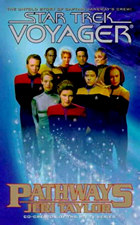 When Captain Janeway's crew accidentally gets between the front lines of an ongoing war while being on an away mission on an unknown planet, they are taken into custody. Separated from Voyager and slowly starving to death in a disease-ridden prison camp, to keep up their determination as they plot their escape, they share with each other the unlikely paths that brought them all together and to the Delta Quadrant.
When Captain Janeway's crew accidentally gets between the front lines of an ongoing war while being on an away mission on an unknown planet, they are taken into custody. Separated from Voyager and slowly starving to death in a disease-ridden prison camp, to keep up their determination as they plot their escape, they share with each other the unlikely paths that brought them all together and to the Delta Quadrant.
Jeri Taylor was involved in the production process of Star Trek Voyager which lends this book a certain quality in giving life to the characters which is unmatched. On about 500 pages Taylor enfolds the background each character has (except for Janeway whose story is told in the separate book Mosaic). Even those storylines evolving pretty much the way you would expect them to are quite entertaining to follow (like Chakotay's), and the ones that don't are fascinating to say the least (like Tom's). The deadly encounter with the hostile aliens and their prison camp merely serves as the framework for the personal stories of Voyager's leading characters told in the third person which makes them even more pleasing to read besides the fact that they're done in such a convincing and brilliant way one is tempted to take Pathways as canon even without the name Jeri Taylor printed on its cover.
So for every Star Trek enthusiast and even for those looking with an skeptical eye on Voyager this book clearly is an important part of the Trek universe and is therefore to be considered as a "must-have".
(Thorsten)
Jeri Taylor, Star Trek Voyager: Pathways, Pocket Books, 1999.
ISBN: 0671026267
Post-Nemesis Era
Star Trek: Typhon Pact: Plagues of Night
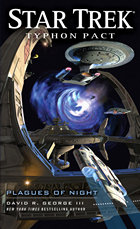 David R. George III's Plagues of Night takes place during trying times for the Federation and its people. While Starfleet deals with the aftermath of the Invasion of 2381 and the consolidated power of the Typhon Pact, Captain Benjamin Sisko faces his own personal battles involving his marriage to Kasidy Yates. The novel continues the narrative from previous entries in the Typhon Pact series and serves as a direct follow-up to Star Trek: Typhon Pact: Rough Beasts of Empire.
David R. George III's Plagues of Night takes place during trying times for the Federation and its people. While Starfleet deals with the aftermath of the Invasion of 2381 and the consolidated power of the Typhon Pact, Captain Benjamin Sisko faces his own personal battles involving his marriage to Kasidy Yates. The novel continues the narrative from previous entries in the Typhon Pact series and serves as a direct follow-up to Star Trek: Typhon Pact: Rough Beasts of Empire.
The novel begins with a covert assault on Utopia Planitia that was described in the Typhon Pact novel Zero Sum Game, but this time we are able to enjoy the action from the Romulan point-of-view. In fact, David R. George III gives us quite a few interesting glimpses of the Federation from the perspective of other local powers. A particularly great scene involves a meeting of the Tzenkethi government, where different factions analyze the Federation's colonization efforts on Laskitor III and other worlds near the Tzenkethi-Federation border. The power play between the different elements of the Tzenkethi political structure reveals that, despite their history with the Federation, there are some who choose to argue for peace.
Federation President Nanietta Bacco's evolving relationships with Praetor Gell Kamemor of Romulus and Castellan Garan of Cardassia contrast well with each other, but also bear some striking similarities. Political maneuvering was a highlight of the DS9 television series, and the author continues that tradition to marvelous effect. The motivations of the Typhon Pact, particularly those of Romulus, are explored in a way that reveals their complexity rather than having them be presented as bland, stereotypical notions of galactic dominance.
The relationship between Captain Sisko and Kasidy Yates is another prominent theme in the novel. While I prefer to see Sisko in the center seat, his self-imposed exile on a starship and the familial problems it causes are truly heart-wrenching. Sisko's frustration also extends to the use of Galaxy-class vessels (including his ship, USS Robinson) to patrol key sectors, rather than allowing them to explore beyond known space. On the other hand, I was somewhat disappointed to see that Kira Nerys wouldn't be returning to Starfleet, instead continuing to pursue a career as a vedek. While I appreciated DS9's inclusion of Bajoran spirituality, I wasn't enthused to see Kira leave the fleet to join the Vedek Assembly. However, the scenes between Sisko and Kira serve to propel the narrative forward.
Plagues of Night is not only a great Star Trek novel, it is also a wonderful piece of Deep Space Nine literature. While continuing to tell the overall tale of post-Destiny Trek, David R. George III injects the storyline with the action, political struggles, and characters that made DS9 so popular. While I personally wasn't fond of the idea of Kira as a vedek, I'm sure many DS9 fans will appreciate the continuity and the inclusion of the Bajoran faith. The author also mixes in some unforeseen twists and unique missions which create a high degree of tension and drama. I highly recommend Plagues of Night to readers of Star Trek literature.
| Trivia | |
|
  Scenes from Plagues of Night (rendered by unusualsuspex) |
(Jay Stobie)
David R. George III, Star Trek: Typhon Pact: Plagues of Night, Pocket Books, 2012. Cover art by Doug Drexler.
ISBN: 978-1451649550
Star Trek: The Fall: Peaceable Kingdoms
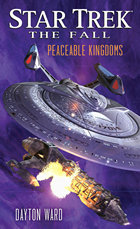 Dayton Ward's Peaceable Kingdoms is the fifth and final novel in Star Trek's
The Fall miniseries, set during tumultuous times for the Federation in late 2385. While Andor is preparing to rejoin the United Federation of Planets, the remaining members are organizing an emergency election to replace the late President Nanietta Bacco. Tensions are high as Captain Picard, Admiral Riker, and Admiral Leonard James Akaar begin to doubt the motives of interim Federation President Pro Tem Ishan Anjar, and questionable orders from the upper echelons of Starfleet cast suspicion about who can truly be trusted.
Dayton Ward's Peaceable Kingdoms is the fifth and final novel in Star Trek's
The Fall miniseries, set during tumultuous times for the Federation in late 2385. While Andor is preparing to rejoin the United Federation of Planets, the remaining members are organizing an emergency election to replace the late President Nanietta Bacco. Tensions are high as Captain Picard, Admiral Riker, and Admiral Leonard James Akaar begin to doubt the motives of interim Federation President Pro Tem Ishan Anjar, and questionable orders from the upper echelons of Starfleet cast suspicion about who can truly be trusted.
Deception is a recurring theme in the novel, as the premise is explored through the circumstances surrounding Bacco's death, Dr. Crusher's covert mission to Jevalan, and the mysterious order for the Federation flagship USS Enterprise-E to deploy to Ferenginar as part of a trivial diplomatic entourage. Picard's meeting with an old friend in command of Starbase 310 is a particularly intriguing scene in which he attempts to ascertain the loyalties of his comrade. The exchange was pleasantly reminiscent of certain elements from the TNG episode "Conspiracy," where allegiance was difficult to determine.
Dayton Ward, the novel's author, also provides us with some excellent character development. The mission to Jevalan presents an opportunity to learn more about the semi-recurring Enterprise security officers Konya and Cruzen. Such characters create a realistic atmosphere by treating readers to glimpses of the various crew members of the Enterprise-E who are outside of the main cast. A starship truly feels alive when you not only know its captain, but also it's deputy chief of security or other officers further down the chain of command. Admiral Riker's new role of overseeing Starfleet Operations is also explored, and I'm sure we all envy his position of allocating Starfleet's vessels and resources to various sectors of Federation space.
The novel also offers a significant amount of action, including phaser fights and starship combat. However, one of the most poignant scenes occurs between Captain Picard, Admiral Riker, and Admiral Akaar. Dayton Ward masterfully defines the ideals laid out by Gene Roddenberry through an eloquent speech by Picard about his perception of Starfleet's charter and its role in the Federation. Peaceable Kingdoms is an excellent conclusion to The Fall, and Ward does a phenomenal job of crafting a standalone story while also wrapping up the majority of the series' various plot lines. Filled with tension, action, and stirring dialogue, Peaceable Kingdoms is a superb addition to the post-Star Trek: Nemesis novels.
| Trivia | |
|
  Scenes from Peaceable Kingdoms (rendered by unusualsuspex) |
(Jay Stobie)
Dayton Ward, Star Trek: The Fall: Peaceable Kingdoms, Pocket Books, 2013. Cover Design by Alan Dingman, Cover Art by Doug Drexler, Cover Nebula by Ali Ries.
ISBN: 978-1476718996
Star Trek: The Next Generation: The Light Fantastic
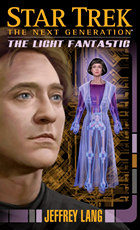 Jeffrey Lang's
The Light Fantastic pits Data and Commander Geordi La Forge against the genius of Professor James Moriarty once again, but this novel is no retread of old storylines. Lang's twists and turns invigorate the rematch into a contest between two beings who have matured and evolved since their last encounter. The author, who previously penned the excellent Immortal Coil, picks up the tale of Data's resurrection and Lal's return from the Cold Equations
trilogy and takes it to new and unexpected heights.
Jeffrey Lang's
The Light Fantastic pits Data and Commander Geordi La Forge against the genius of Professor James Moriarty once again, but this novel is no retread of old storylines. Lang's twists and turns invigorate the rematch into a contest between two beings who have matured and evolved since their last encounter. The author, who previously penned the excellent Immortal Coil, picks up the tale of Data's resurrection and Lal's return from the Cold Equations
trilogy and takes it to new and unexpected heights.
The first element of this novel that jumps off the pages is the amazing character development. Data, La Forge, and Moriarty have changed drastically in the many years since their last encounter. Lang expertly crafts the evolution of the characters, particularly Data's life after his resurrection and Moriarty's tenure in the memory solid, into the narrative. Data's daily routine on Orion is an intriguing highlight, especially his employment as a short-order cook in a diner. La Forge was the perfect choice to accompany Data on his quest to save his daughter Lal from Moriarty. In the game of wits between android and hologram, Geordi provides the human counterpoint to Data's struggles with his emotions as a parent and the ambiguous morality he inherited from his own father.
Well-established Star Trek characters aren't the only ones to receive the benefit of development. The character of Lal, who only appeared in one episode of The Next Generation, is skillfully displayed as a unique individual, and her relationship with her father is fascinating to say the least. Shakti, the artificial intelligence who "assists" Data aboard his ship Archeus, and Albert Lee, formerly of the USS Enterprise-D, receive a great deal of attention as well. The two characters add a great deal of charm and humor to the story.
Lang also does an exceptional job of weaving the threads of Trek's numerous artificial intelligence-related storylines into elements of The Light Fantastic. The components from other Trek stories that are utilized by the author fit flawlessly into the plot, and they do not feel like an attempt to simply dazzle the audience with familiar faces. Rather, each of these artificial intelligence-related references serve to propel the narrative and are vital to its conclusion. As before, Lang makes sure that any recognizable figures who pop up have evolved since the last time they were seen.
The Light Fantastic is a superb, character-driven novel that reintroduces Data, Professor James Moriarty, and Lal in a unique and entertaining way while still providing the hazy line between good and evil that marked the Enterprise crew's previous dealings with Moriarty. Data's relationship with both his morality and his daughter are compelling, as are Moriarty's motives and La Forge's skepticism. Several of Star Trek's artificial intelligence-related plots are skillfully brought together in an almost "Seinfeldian" fashion at different points in the novel. The Light Fantastic is not only a superb follow up to Immortal Coil and the Cold Equations trilogy, but also a fitting and original sequel to The Next Generation's saga of Professor James Moriarty and Data's resurrection.
(Jay Stobie)
Jeffrey Lang, Star Trek: The Next Generation: The Light Fantastic, Pocket Books, 2014.
ISBN: 978-1476750514
Star Trek: Deep Space Nine: Lust's Latinum Lost (and Found)
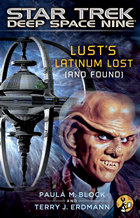 Veteran Star Trek non-fiction writers Paula M. Block and Terry J. Erdmann, whose numerous
Trek-related credits include the spectacular Deep Space Nine Companion
reference work, have now ventured into the realm of post-Nemesis fiction with the release of the e-novella Lust's Latinum Lost (and Found). The tale focuses on the beloved character of Quark and, as the title implies, the Ferengi's pursuit of cornering the market on a new holonovel that could have him drowning in his favorite gold-pressed liquid.
Veteran Star Trek non-fiction writers Paula M. Block and Terry J. Erdmann, whose numerous
Trek-related credits include the spectacular Deep Space Nine Companion
reference work, have now ventured into the realm of post-Nemesis fiction with the release of the e-novella Lust's Latinum Lost (and Found). The tale focuses on the beloved character of Quark and, as the title implies, the Ferengi's pursuit of cornering the market on a new holonovel that could have him drowning in his favorite gold-pressed liquid.
Lust's Latinum Lost opens with Quark feeling dismayed about his establishment's profits. While this is a common theme in Quark's life, Block and Erdmann perfectly capture Quark's sense of frustration and self-pity. Rionoj, Quark's Boslic "friend" and freighter captain, soon arrives with something that could easily cure Quark's woes: an advance copy of Lust's Latinum Lost, the fourth installment of the infamous Vulcan Love Slave holonovels. However, by the time Quark samples the work and decides to purchase it, Rionoj has left the station. Afraid of being usurped by another buyer, Quark sets out on a quest to find a copy of the program for himself.
Accompanying Quark on his wild ride is Shmenge, Quark's newest "apprentice" who arrives courtesy of a friend of Quark's mother Ishka. Shmenge proves to be an entertaining addition to the DS9 family of characters and an excellent scapegoat for Quark's mistakes. Shmenge's naïve, yet inquisitive, nature creates a unique friction with Quark that hasn't been seen since the departure of Rom. Hopefully, readers will be treated to more of Shmenge's antics in the future.
The knowledge about the series that Block and Erdmann possess is astounding and prevalent. The writers do a tremendous job of incorporating Lust's Latinum Lost into the series itself and the post-series novels. References that had been lacking in recent DS9 novels, ranging from recurring characters from the show to Gamma Quadrant residents, such as the Dominion and Argrathi, demonstrate why these authors deserve to be at the helm for DS9 fiction. Throw in a Nausicaan, Chief O'Brien, and a trip to Wrigley's Pleasure Planet, and the tapestry of the Trek universe becomes even more tangible.
In fact, the trip to Wrigley's Pleasure Planet is interesting as both an element of the plot and as a piece of the Federation. I always enjoy when we are treated to learn about the geography of Federation worlds, especially with aptly named locations such as Debauche and Desire Island. Discovering the locales of a world, whether they be planetary capitals or historic landmarks, allows the reader to experience these planets rather than just viewing them as names on a map or vague references made during episodes. The more readers know about Wrigley's Pleasure Planet, or any other member of the Federation, the more they can immerse themselves in the experience. Block and Erdmann accomplish this feat in a superb fashion.
While Lust's Latinum Lost (and Found) is an e-novella, Block and Erdmann supply an entire novel's worth of adventure. Original characters and locations, clever references to the series, and an exciting plot combine to create one of the best post-series works to date. The authors have not only mastered the prose of DS9, but they have breathed new life into the character of Quark. Lust's Latinum Lost is a must read for fans of Quark, the Ferengi, and DS9, as well as for Star Trek fans in general.
(Jay Stobie)
Paula M. Block & Terry J. Erdmann, Star Trek: Deep Space Nine: Lust's Latinum Lost (and Found), Pocket Star, 2014.
ISBN: 978-1476779317
Star Trek: Section 31: Disavowed
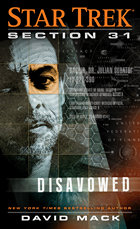 Disavowed heralds the return of the mysterious, shadow organization Section 31, which operates clandestinely outside of the law without oversight or accountability to protect the interests of the Federation. The plot focuses on Dr. Julian Bashir, recently discharged from Starfleet due to his unauthorized actions to help solve the Andorian fertility crisis, and Sarina Douglas, who resigned her own commission to live with Bashir on Andor. The pair, whose genetically enhanced abilities make them valuable assets in the eyes of Section 31, set out to infiltrate the organization in order to facilitate its downfall. However, a mission to the mirror universe being conducted by the Breen poses a danger that Bashir, Douglas, and Section 31 all hope to prevent.
Disavowed heralds the return of the mysterious, shadow organization Section 31, which operates clandestinely outside of the law without oversight or accountability to protect the interests of the Federation. The plot focuses on Dr. Julian Bashir, recently discharged from Starfleet due to his unauthorized actions to help solve the Andorian fertility crisis, and Sarina Douglas, who resigned her own commission to live with Bashir on Andor. The pair, whose genetically enhanced abilities make them valuable assets in the eyes of Section 31, set out to infiltrate the organization in order to facilitate its downfall. However, a mission to the mirror universe being conducted by the Breen poses a danger that Bashir, Douglas, and Section 31 all hope to prevent.
Much like the Section 31 organization it describes, this novel is full of unexpected twists and turns, along with fast-paced and brutal action sequences. David Mack does an excellent job of taking the reader's expectations for the next step of the plot and refreshingly shredding them to pieces. Mack, who has probably killed more sentient beings in his work than any Trek author in history, is masterful in his description of various combat scenarios, infiltration attempts, and tactical deployments. While this may not be a side of Star Trek that most fans are accustomed to, it perfectly captures the shadow organization upon which the novel is focused.
I particularly enjoyed the Galactic Commonwealth, the mirror universe government created by humans, Vulcans, Andorians, and other species once they were able to overthrow the Klingon-Cardiassian Alliance depicted in various episodes of Deep Space Nine. Their technology, which includes "jaunt ships" that utilize artificial wormholes for propulsion, is fascinating and their society is an interesting reflection of the Federation. While they only had a minor role, former Klingon-Cardassian Alliance operatives Regon and Kort were also an entertaining pair who sought to undermine the stability of the Commonwealth.
While this is not technically a Deep Space Nine novel (although Bashir and Douglas are DS9 characters), David Mack depicts one of the crucial aspects of that series: political intrigue. In our universe, Section 31 acts against a joint venture between the Breen Confederacy and Tzenkethi Coalition, while Starfleet Intelligence hopes to take down Section 31. In the mirror universe, a complex political battle is waged between the Galactic Commonwealth, the Dominion, the Taurus Pact (similar to the prime universe's Typhon Pact), and the aforementioned agents of the defunct Klingon-Cardassian Alliance. Reading the novel feels almost like watching an action-packed story arc from the series.
Star Trek: Section 31: Disavowed is an entertaining novel with well-developed characters, gripping political intrigue, and unexpected twists and turns. While the Federation does have slipstream propulsion, this novel sparks the imagination and makes the reader wonder what it would be like if Starfleet vessels had the wormhole-drives of their jaunt ship counterparts in the Galactic Commonwealth. David Mack continues to successfully develop the relationship between Dr. Bashir and Sarina Douglas, and he once again proves that these two characters can helm the main plot of a Trek novel.
(Jay Stobie)
David Mack, Star Trek: Section 31: Disavowed, Pocket Books, 2014.
ISBN: 978-1476753089
Star Trek: Deep Space Nine: The Missing
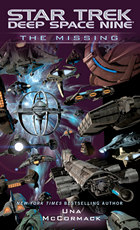 The Missing, by Una McCormack, focuses on several different plots that take place on Deep Space 9 and the Olympic-class research vessel Athene Donald. Mysterious travelers known as the People of the Open Sky intrigue Dr. Beverly Crusher, a Tzenkethi refugee contemplates her future, and a brewing political incident between the Cardassians and Romulans highlight the action on board Deep Space 9. On the Athene Donald, Dr. Katherine Pulaski and the rest of the crew are confronted by a strange, and possibly hostile, vessel from a race known as the Chain.
The Missing, by Una McCormack, focuses on several different plots that take place on Deep Space 9 and the Olympic-class research vessel Athene Donald. Mysterious travelers known as the People of the Open Sky intrigue Dr. Beverly Crusher, a Tzenkethi refugee contemplates her future, and a brewing political incident between the Cardassians and Romulans highlight the action on board Deep Space 9. On the Athene Donald, Dr. Katherine Pulaski and the rest of the crew are confronted by a strange, and possibly hostile, vessel from a race known as the Chain.
I have mixed feelings about this novel, but I would like to start with (and also focus on) its positive elements. Bringing back Dr. Pulaski as a protagonist is a brilliant move, and McCormack does an excellent job of bringing the character back to life. The evolving relationship between Crusher and Pulaski is another noteworthy highlight, and so is the spirit of exploration, discovery, and unity that the Athene Donald's mission represents. In previous post-Star Trek: Nemesis works, I was disappointed by the seeming disconnect between Odo and his former co-workers. The character seemed unnaturally cold toward them, even more than when he kept to himself during the early years of the series. However, McCormack brings back the Odo we remember from the final seasons of DS9, and it is a welcome return.
As I've just mentioned, there is a great deal to enjoy about this novel. However, in my opinion, the stories told suffer from one key fact: the Tzenkethi, the People of the Open Sky, and the Chain just aren't very interesting species. The Tzenkethi, whose shortcomings are not solely confined to this specific novel, have been portrayed as devious to outsiders and controlling over their own people. Their capabilities to change color and contort their bodies just doesn't spark my imagination like other prominent Trek species, such as the Klingons, Romulans, and Cardassians. As for the People and the Chain, there isn't much I can say about either species without revealing elements of the plot, but neither jumped off the page to me. It's unfair of me to compare these new species to those who had a chance to be developed on-screen, but nevertheless, the post-Nemesis novels have yet to produce an intriguing, recurring alien species of their own.
As for the plot involving the Cardassians and the Romulans, it was definitely enjoyable to once again see Garak in his new role as Castellan of the Cardassian Union. The squabble brought back the political turmoil that frequently occurred during the TV series, and it was a welcome addition to the novel. The presence of a Tzenkethi and Romulans amongst the crew of the Athene Donald provided some additional political intrigue. In fact, the political posturing and the aforementioned mission of exploration being undertaken by the Athene Donald were two of the most refreshing parts about The Missing.
Despite the negatives I have pointed out, I encourage readers to give this novel a chance. While I may not have been intrigued by the Tzenkethi, the People, or the Chain, I'm sure there are many readers who would disagree with me. In fact, I think this novel would have made a decent episode during the run of the TV series in the format of a 45-minute episode. With some solid acting, decent alien make-up, and dazzling special effects, I think it could fit into any season of DS9. However, I just didn't feel as if The Missing held its own as a novel.
(Jay Stobie)
Una McCormack, Star Trek: Deep Space Nine: The Missing, Pocket Books, 2015.
ISBN: 978-1476750231
Star Trek Picard: The Last Best Hope
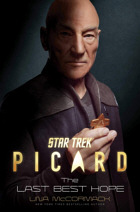 The first novel to tie into Star Trek: Picard, The Last Best Hope, takes us through events from 2381 to 2385, from the first indications that the Romulan sun is undergoing collapse to the synth attack on Mars. The novel sets up everything for the first season of Picard, so it's no wonder it feels heavy. Arguably, McCormack has been asked to cover too much in one volume, and that it remains readable and largely entertaining is to her credit.
The first novel to tie into Star Trek: Picard, The Last Best Hope, takes us through events from 2381 to 2385, from the first indications that the Romulan sun is undergoing collapse to the synth attack on Mars. The novel sets up everything for the first season of Picard, so it's no wonder it feels heavy. Arguably, McCormack has been asked to cover too much in one volume, and that it remains readable and largely entertaining is to her credit.
Covering such a long span of time and such a broad scope of events make this as much a historical text as a novel, and it has to be said that some periods of the book are very dry indeed. Where the novel excels, though, is in its depiction of its central characters. McCormack clearly knows her Jean-Luc Picard – his (rather long) log entries bring each new chapter up-to-date and you can absolutely hear them in Patrick Stewart's voice. The novel begins with him making a stand for the Romulan relief effort, leading to his (long overdue) promotion to admiral and assignment as head of the taskforce. The many characters introduced for the novel or taken from the Picard series itself are equally well-drawn and evocative. Notable new characters include Koli Jocan, a young Bajoran brought onto the taskforce as a refugee specialist and Tajuth, a Romulan liason (read: spy) who is inscrutable at first but who becomes more sympathetically drawn over time.
Raffi Musiker is easily the most well-rounded and fleshed out of the Picard characters, and the insight into her background is illuminating. We follow her story as she is assigned to the Romulan relief effort, recruited by Picard as first officer on his flagship, the USS Verity, due to her specialism in Romulan culture. We see their relationship develop, as their mismatched but complementary styles mvoe them from colleagues to friends. As the relief effort jumps from low to high to low, we share in Raffi's frustration, which, combined with her ongoing separation from her family, has a clear impact on her mental wellbeing.
Indeed, frustration is the overwhelming emotion that runs through the novel. At every step of the way, the Romulan government makes things as difficult as possible for the Federation in their efforts to help them. The Romulan civilisation is portrayed as pathologically incapable of being open and honest, with their own people or the Federation. There are several subplots exploring this, including an ongoing storyline set both at Cambridge and on Romulus, where astrophysicists on both sides make discoveries that show the supernova is going to be even more destructive than previously thought, only to be silenced by the Tal Shiar. The Romulan government repeatedly lies to its people about the danger posed, and to the Federation about how capable they are in evacutating their people. Towards the end of the novel, we see this in microcosm, where a wealthy governer refuses to allow his colony to be evacuated, and even erects a forcefield around the place to impede beaming, utterly convinced that the stories of the supernova are Federation lies, even as the changes in solar activity are devastating the climate. It's clearly a comment on the kneejerk refusal of so many in power to accept the reality of climate change on Earth.
Even the Federation is reluctant to help on many fronts, from the top to the bottom. Some of this is undertandable; in universe, this is only six years after the end of the Dominion War, a hugely costly conflict ending with the UFP moving in to offer aid. Other protests come from further down the hierarchy – a major subplot follows Olivia Quest, an up-and-coming politician from a border colony who gets elected to the Federation Council and becomes an unofficial spokesperson for colonies who are sick of seeing resources diverted to help what was, until recently, a major enemy.
The other major storyline is the creation of the synths. Geordi la Forge is assigned to head up the Martian taskforce to build the thousands of ships needed to engage the relief effort. There's a very logical explanation for the need for synthetic workers: many of the parts for starships are complex, hand-built devices that can't be simply replicated, and the trained manpower simply doesn't exist. Synthetic humanoids are the solution, and to make this happen, Geordi calls in Burce Maddox, who resents his work on creating new life being diverted to create "toys." (I still don't understand why holograms aren't an easier solution, but that's by the by.)
On the whole, The Last Best Hope is a well-written but necessarily dense book that won't be everyone's cup of tea. There are a lot of subplots and characters which keeps things interesting, but the amount of material to cover might make it a bit of a slog for some. Myself, I enjoyed it, and it has a lot to say both about the future history of the Star Trek universe and the world we find ourselves in today. It'll be interesting to see how Star Trek: Picard affects the Pocket Books series overall; the books have been slowly moving towards the time of the supernova, and this book overlaps with their timescale while also invalidating large swathes of their continuity. If you're a fan of Star Trek: Picard's first season, I can certainly recommend this as essential reading, but if you're after a standalone Star Trek adventure, it's not going to hit the spot.
- Remarkable officer: Upon Picard's promotion and reassignment, Worf is made captain of the Enterprise-E. Picard fights for this, considering that not only is Worf the ideal candidate, but that having a Klingon command Starfleet's capital ship is a strong symbol of unification with former enemies.
- Remarkable references: McCormack named the Verity after her daughter, and set several scenes at Cambridge University, where the author once taught. Admiral Clancy is given the first name Kirsten, after Picard co-creator (and fellow Pocket Books author) Kirsten Beyer.
- Remarkable starship: The USS Verity NCC-97000 is an Odyssey-class starship – the same as the apocryphal Enterprise-F from Star Trek Online continuity.
- Remarkable planet: We finally return to Nimbus III, long since ceded to the Romulans and still a lawless colony. The Romulan intervention on the planet when colonists refuse to evacuate is catastrophic.
- Remarkable lost plots: There's an ongoing thread at Cambridge showing evidence that the supernova is not natural, which is revisited several times, and then dropped, unresolved. This is frustrating, and I can only assume it will be picked up in either a future book or the series itself.
Una McCormack, Star Trek Picard: The Last Best Hope, Pocket Books, 2020.
ISBN: 1982139447
See Also
Fan Fiction @EAS - collection of over 150 stories by 27 authors















